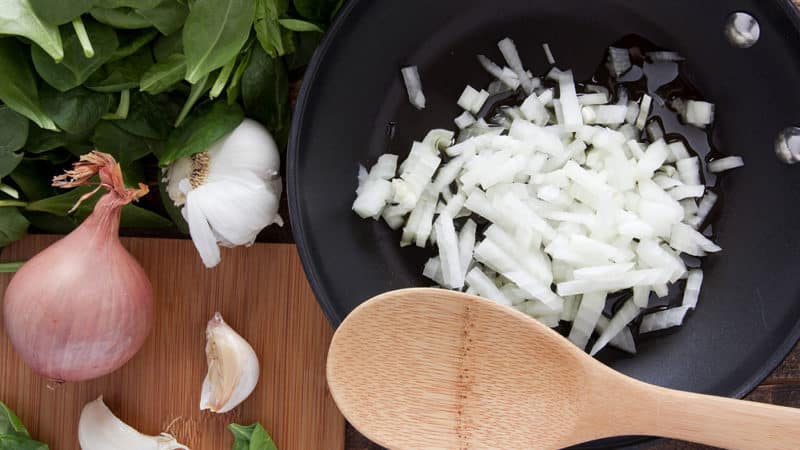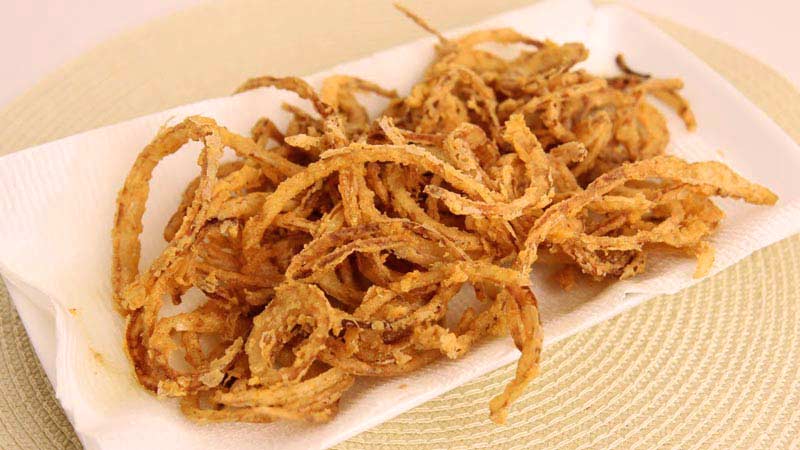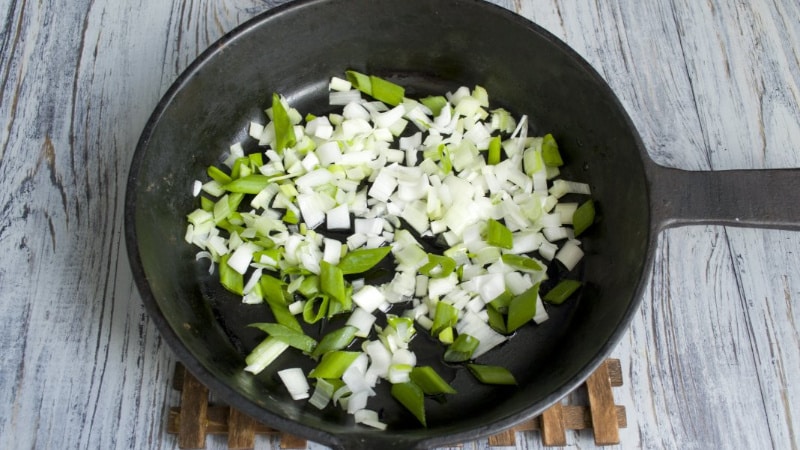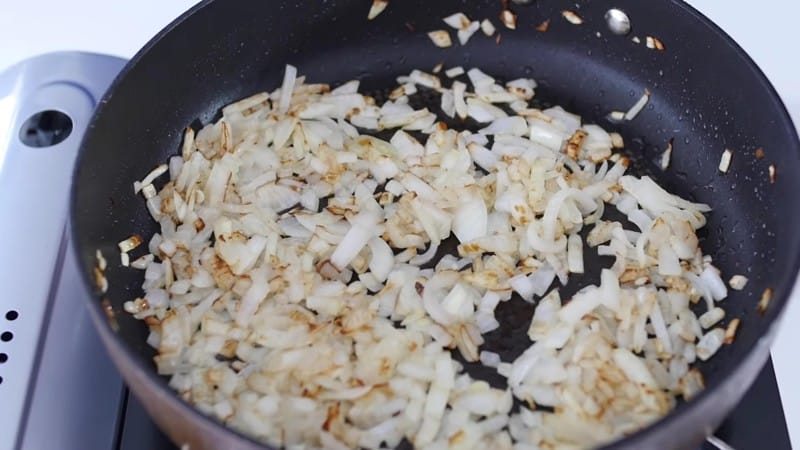Is it possible to eat fried onions while losing weight and what is their calorie content?
Onions are a vegetable that almost no dish can do without. It is added to salads, soups, sauces, side dishes, baked goods, and meat dishes. Many use it is fresh, but when cooked it is no less useful.
From the article you will learn how many calories are in fried onions, what beneficial properties they have and whether there are contraindications to their use.
Chemical composition and nutritional value
100 g of product contains:
- vitamins:
- PP – 0.9 mg;
- E – 0.7 mg;
- K – 21.6 mcg;
- C – 1.8 mg;
- B1 – 0.05 mg;
- B2 – 0.02 mg;
- B4 – 6.5 mg;
- B5 – 0.2 mg;
- B6 – 0.2 mg;
- B9 – 2 mcg;
- B7 – 0.9 mcg.
- microelements:
- phosphorus – 33 mg;
- sodium – 12 mg;
- potassium – 133 mg;
- calcium – 20 mg;
- manganese – 0.1 mg;
- iron – 0.3 mg;
- magnesium – 9 mg;
- zinc – 0.2 mg;
- iodine – 3 mcg.
- essential oils;
- amino acids.
Calorie content, dietary fat and glycemic index

Nutritional value per 100 g:
- 4.5 g proteins;
- 13.5 g fat;
- 27.5 g carbohydrates;
- 5.8 g dietary fiber;
- 45 g water;
- 3.9 g starch;
- 2.7 g of ash.
Typically, the calorie content of onions depends on the chosen cooking method: fried in sunflower oil - 251 kcal per 100 g, and fried in olive oil - 256 kcal.
The glycemic index of raw onions is 15, but when frying, this figure rises to 98.
Attention! To preserve nutrients, fry the vegetable in refined olive oil with the lid open.
Beneficial properties for the body
Onions have the following properties:
- strengthens the immune system, and the high content of vitamins improves body tone and improves health;
- thanks to folic acid, it is useful for pregnant women - it is involved in the formation of the fetus and improves mood;
- recommended for people suffering from diabetes, stimulates insulin production;
- has calming properties, improves sleep quality;
- fights fungal diseases;
- used in cosmetology – affects the condition of hair, skin and nails;
- improves metabolism, improves food digestion;
- has a diuretic effect;
- relieves swelling;
- normalizes water-salt balance;
- removes toxins and waste from the body;
- increases iron levels in the blood.
Fried onions are included in the diet by those who suffer from:
- atherosclerosis;
- kidney diseases;
- oncology;
- colds and viral diseases.
Harm and contraindications for use
Despite a number of positive properties, there are contraindications:
- Gastritis and ulcers, especially during exacerbation, problems with the pancreas.
- Liver diseases. Due to the high fat content after frying, such food increases the load on the organ.
- Allergy and individual intolerance.
- Childhood — fried onions are difficult to digest.
- Problems with the heart and blood vessels. In large doses, it provokes sudden surges in blood pressure, headaches, and tachycardia.
- Asthma. This happens rarely, but an attack of suffocation due to the specific smell is still possible.
Heat-treated vegetables can cause heartburn, bloating, and bad breath.
Consumption rate

Adults who have no contraindications are recommended to consume fried onions 2-3 times a week.The serving size depends on the individual characteristics of the body and personal taste preferences. On average - no more than 100 g.
Important! Excessive consumption of fried onions may cause health problems.
How to reduce the calorie content of fried onions
It would seem that there is nothing easier than frying onions. But for greater benefits, follow the recommendations for preparing this product.
How and what to fry on
Any variety of onion is suitable for heat treatment, but the more bitter ones are best. The vegetable is used as an independent dish, as a roast for soups and borscht, and as a side dish.
Attention! The calorie content of onions fried in vegetable oil ranges from 215 to 250 kcal.
Here are some tips on how to reduce the calorie content of onions when frying:
- Rinse, peel, cut and dry it using paper towels or napkins. This removes excess moisture and allows the onions to absorb less oil during cooking.
- Fry in various oils: sunflower, coconut, olive, flaxseed, butter. The lower the energy value of the oil, the lower the calorie content of the onion.
- Frying oil is diluted with water in a 1:1 ratio. When frying, do not cover the pan with a lid - this will evaporate the liquid faster.
- After frying, pat the finished product dry with a paper towel to absorb excess oil.
How to fry onions: simple but tasty recipes

Preparation:
- Cut 200 g of onion or divide it into rings.
- Place in a deep container and add 4 tbsp. l. flour. To make the dish dietary, use oatmeal, corn or whole grain. Stir gently.
- Add oil to a heated frying pan and add onions. Don't forget to stir. Cook until golden brown over low heat.Add salt at the end of frying, otherwise the onion will become too soft.
You can also cook the vegetable in the oven:
- Preheat the oven to 180°C.
- Cut the onion into rings, roll in flour, egg and breadcrumbs.
- Grease a baking sheet with oil, place the rings and bake for 20 minutes.
This option will replace chips.
Is it possible to eat it while losing weight?

To reduce the calories in fried onions, use water instead of frying oil. Finely chop the vegetable, place the frying pan on low heat, add the onion, stir constantly. To give it a richer taste, add a small amount of vinegar. If you want to sauté the onions, add more water to the pan.
For people who want lose weight, You should limit your consumption of fried onions. In moderation, it has a beneficial effect on metabolism, but if you overdo it, it provokes weight gain.
Conclusion
Onions are an invaluable source of vitamins and minerals, not only raw, but also fried. If you want to stay healthy and fill your body with useful substances and vitamins, then include fried onions in your diet.
Remember that you should use it in moderation and follow the cooking recommendations, otherwise you risk harming your health.